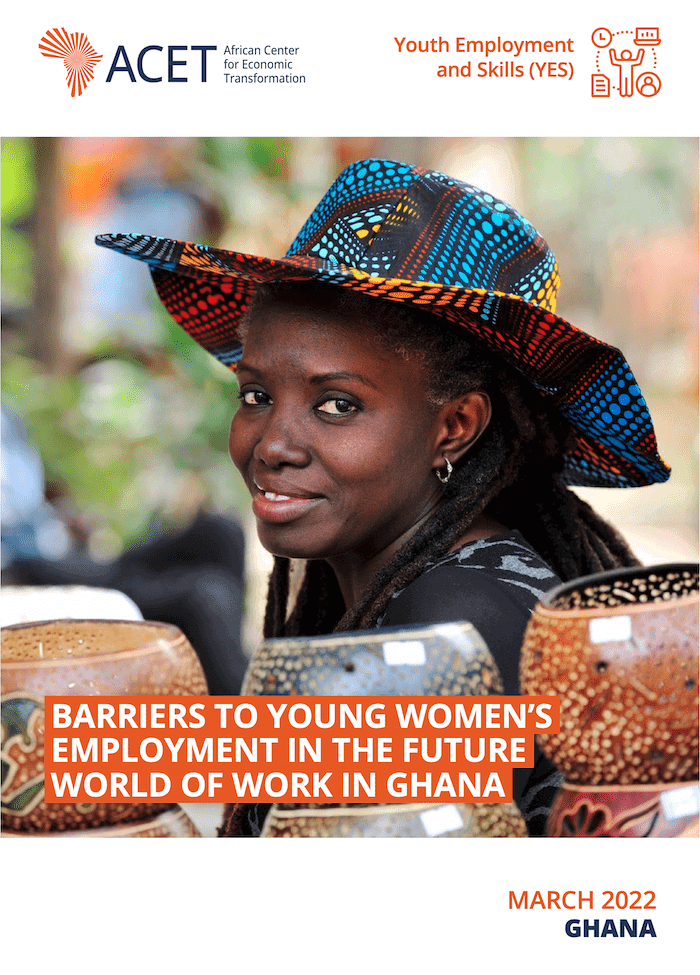Ghana’s population is youthful, with a total population projected to be 31.1 million as of July 2021 yet a median age of 21.5 years. Urbanization has been rapid—currently about 57 percent of the population resides in urban areas—although the rate of urbanization differs across regions in the country. The labor force participation rate of the population aged 15 years and above was 75.2 percent in 2015; this was higher for men (79 percent) compared to women (72 percent). In 2017, the unemployment rate stood at 5.1 percent, with the incidence of unemployment being higher for women (5.7 percent) than for men (4.5 percent). Women are more likely to enter the labor market at an earlier age than men because a greater proportion of women have never attended school and girls drop out of school earlier than boys.
The Ghanaian economy has on average performed well in the last two decades, with a slowdown in growth in recent times; this growth is, however, yet to be reflected in employment creation and improvements in employment conditions for many, especially youth. In the area of education, the country has made strides recently with a near parity in both primary and secondary enrollment, particularly since the launch of a nationwide free secondary education program in 2017. At the tertiary level, a gender parity of 0.8 for gross enrollment is an indication that learning opportunities still favor men over women. In the labor market, two out of every three young women (aged 15–35 years) in Ghana are in vulnerable employment with low earnings and no access to formal work arrangements including decent working conditions and social security.
In general, gender barriers that affect women in education and in the labor market remain pervasive despite attempts to achieve gender equality in the country as enshrined in the 1992 Constitution. Important indicators of the country’s dedication to promote gender equality include the commitment of the country to the United Nations’ Sustainable Development Goals, creation of the Ministry of Women and Children in 2001 (renamed the Ministry of Gender, Children and Social Protection in 2013), and the development of a National Gender Policy in 2015. Other policies adopted at the national level to address gender inequality in the areas of healthcare, employment, and education include the National Adolescent Health Policy (2000), the National Health Insurance Scheme (2003) for the provision of affordable healthcare for all citizens, and the Education Strategic Plan 2018–2030 aimed at achieving equitable access to good quality and gender parity in education.
Although these policy commitments are important indicators of the quest for gender equality in areas of leadership, women’s empowerment, and livelihood opportunities, among others, they have yielded minimal results across all spheres of national life. This is reflected in the low representation of women in decision-making and elective office; women constitute about 15 percent of members in the 8th Parliament (2021) although they constitute nearly 51 percent of the population. Women and girls have fewer opportunities than men and boys in almost all spheres of national life. The negative effects of gender barriers add up over their life cycle and are transmitted to future generations resulting in intergenerational transfers of constraints and barriers that limit young women’s opportunities in the world of work.
Constraints faced by young women are often the result of differential access to opportunities of education and skills training and employment-enabling resources. Such disparities are likely to be worsened by the incidence of the COVID-19 pandemic that has adversely affected the world economy, and Ghana is no exception. Consequently, this study hypothesizes that, in the presence of traditional gender barriers, new challenges due to the changing nature of work may have arisen that could potentially hold back the development and employability of young women in the future world of work in Ghana.
This study therefore focuses on young women (aged 15–35 years) in the three selected sectors, namely agriculture, business process outsourcing (BPO), and tourism and hospitality, with the following objectives:
- Identify the unique factors that hamper young women’s education from childhood to the world of work in the selected sectors.
- Investigate the unique out-of-school gender barriers that deny young women the opportunities to advance in the world of work in the selected sectors.
- Identify and propose policy options that can help young women acquire and develop the necessary education and skills for the future world of work.



